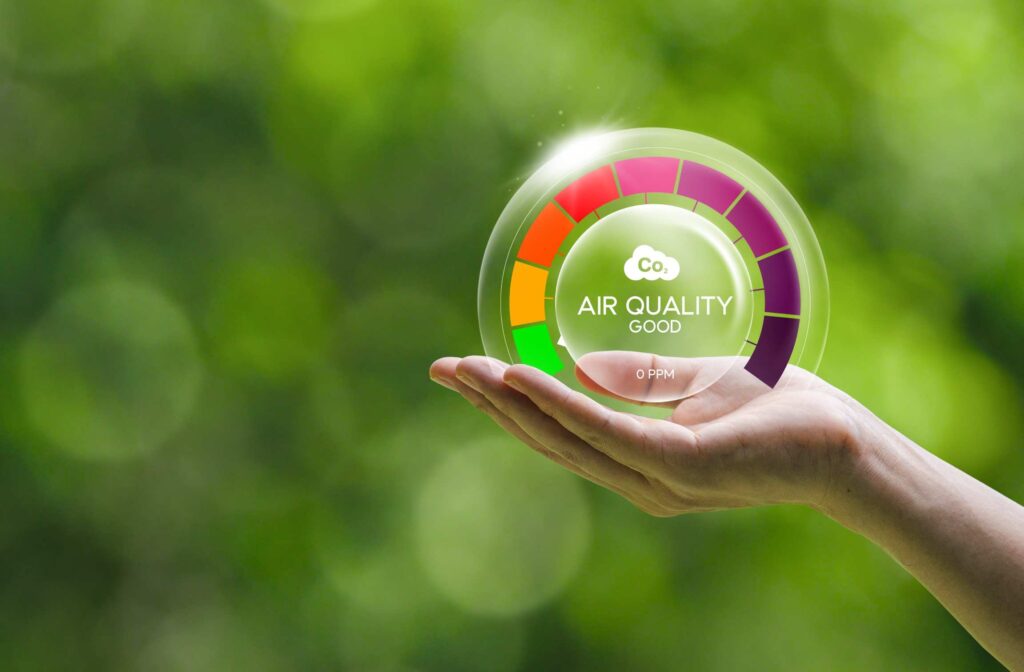
Indoor air quality (IAQ) has a significant impact on your health and well-being. Poor IAQ can exacerbate allergies, cause respiratory issues, and affect your overall quality of life, but many people overlook it. For Chicago residents, the challenges of maintaining clean air indoors are even greater, as city living introduces unique factors like pollution, older housing materials, and damp weather conditions that can foster mold growth.
How do you test or improve the air quality in your home? This guide covers common indoor pollutants, testing options, and practical solutions to create a healthier indoor environment for you and your family.
Common Indoor Air Pollutants in Chicago Homes
Indoor air quality issues often start with pollutants. Knowing what you’re dealing with is the first step toward improving your air quality. Here are the most common culprits found in homes in Chicago.
Mold
Mold thrives in damp conditions, such as basements, bathrooms, and kitchens. Chicago’s humid summers and poorly ventilated older homes create ideal conditions for mold growth. Mold exposure can lead to respiratory problems, headaches, and allergies.
Radon
Radon is a colorless, odorless radioactive gas that naturally occurs from the decay of uranium in soil. Illinois is known for having radon hotspots, and many homes in Chicago may unknowingly have dangerous levels. Radon exposure poses serious health risks, including lung cancer.
Asbestos
Homes and buildings built before the 1980s often used asbestos in insulation and fireproofing materials. When disturbed, asbestos fibers can become airborne and cause long-term health complications like mesothelioma and asbestosis.
Volatile Organic Compounds (VOCs)
VOCs originate from everyday household items, including cleaning products, paints, furniture, and even air fresheners. They release toxic chemicals into the air that can irritate the eyes, nose, and throat, and contribute to more serious conditions over time.
By recognizing these pollutants in your home, you can take steps to tackle them. But first, you need to confirm they’re present.
How to Test Your Home’s Air Quality
How do you check the air quality in your home? Testing is the crucial next step. You can either use DIY kits or seek professional indoor air testing services, depending on your preferences and needs.
DIY Testing Kits vs. Professional Air Quality Testing
DIY Testing Kits
These are affordable and widely available for specific pollutants, such as radon or VOCs. However, they may not provide a comprehensive analysis and could miss less obvious issues.
Professional Air Quality Testing
This is a more thorough approach. Experts assess a wide range of pollutants, use sophisticated tools, and provide actionable recommendations. Hiring professionals ensures nothing gets overlooked.
What to Expect During Professional Air Quality Testing
Professional air quality testing typically involves the following steps:
- Assessing the air and surfaces for mold, asbestos, and VOCs
- Using radon detectors for continuous monitoring
- Collecting samples to analyze pollutant levels
Benefits of Professional Indoor Air Testing
- Comprehensive understanding of air quality
- Accurate data for tailored solutions
- Opportunity to consult with experts about long-term improvements
Testing provides peace of mind and sets the stage for effectively addressing any IAQ issues you uncover.
Solutions for Improving Indoor Air Quality
Once you understand the problem, it’s time to find solutions. Here are proven strategies for improving indoor air quality in Chicago homes.
Air Purification Systems
High-quality air purifiers with HEPA filters effectively capture allergens, mold spores, and volatile organic compounds (VOCs). Consider innovative models that adjust purification levels automatically based on air conditions.
Ventilation Improvements
Proper ventilation ensures stale indoor air doesn’t linger. Consider installing exhaust fans in kitchens and bathrooms, or opting for whole-house ventilation systems that regulate airflow.
Moisture Control to Prevent Mold Growth
Reducing moisture levels is key to combating mold. Use dehumidifiers in damp areas, fix leaks immediately, and ensure proper drainage around your home’s foundation.
Radon Mitigation
If radon levels are high, consider installing a radon mitigation system. This typically involves creating a venting system that directs radon out of your home and away from living spaces.
Taking these steps will dramatically improve the air you breathe and protect your family’s health.
Green Home Solutions: Your Chicago IAQ Experts
At Green Home Solutions, we specialize in creating healthier indoor environments for residents of Chicago. With expert services and eco-friendly methods, we tackle pollutants head-on.
Our Services at a Glance
-
Radon mitigation solutions
Why Choose Green Home Solutions
- Decades of experience in IAQ solutions
- Thorough testing and customized strategies
- Focus on sustainable and eco-friendly practices
We’ve helped countless Chicagoans breathe easier, and we’re ready to help you, too.
Breathe Easier Today
It’s time to take control of your home’s air quality. From understanding common pollutants to implementing tailored solutions, improving your indoor air quality is a step-by-step process. And with Green Home Solutions by your side, the process becomes simple and stress-free.
Schedule an indoor air quality test today and start your journey to a healthier home!
